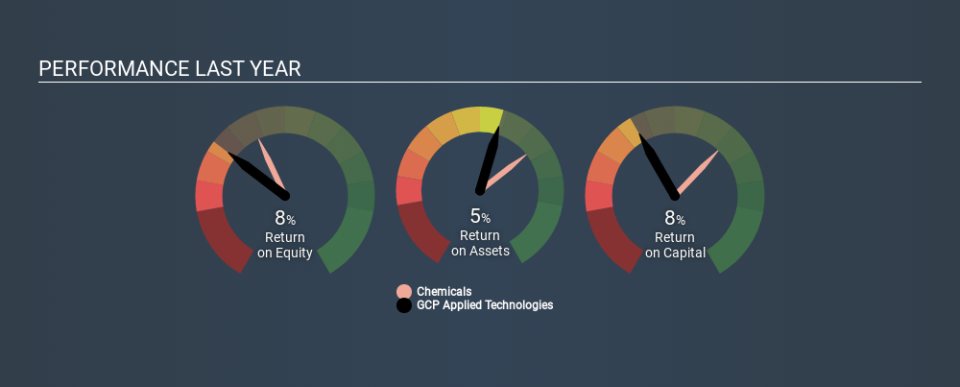What We Think Of GCP Applied Technologies Inc.’s (NYSE:GCP) Investment Potential

Today we are going to look at GCP Applied Technologies Inc. (NYSE:GCP) to see whether it might be an attractive investment prospect. Specifically, we'll consider its Return On Capital Employed (ROCE), since that will give us an insight into how efficiently the business can generate profits from the capital it requires.
First up, we'll look at what ROCE is and how we calculate it. Second, we'll look at its ROCE compared to similar companies. Finally, we'll look at how its current liabilities affect its ROCE.
What is Return On Capital Employed (ROCE)?
ROCE measures the 'return' (pre-tax profit) a company generates from capital employed in its business. All else being equal, a better business will have a higher ROCE. Ultimately, it is a useful but imperfect metric. Renowned investment researcher Michael Mauboussin has suggested that a high ROCE can indicate that 'one dollar invested in the company generates value of more than one dollar'.
How Do You Calculate Return On Capital Employed?
Analysts use this formula to calculate return on capital employed:
Return on Capital Employed = Earnings Before Interest and Tax (EBIT) ÷ (Total Assets - Current Liabilities)
Or for GCP Applied Technologies:
0.084 = US$92m ÷ (US$1.3b - US$213m) (Based on the trailing twelve months to December 2019.)
So, GCP Applied Technologies has an ROCE of 8.4%.
View our latest analysis for GCP Applied Technologies
Does GCP Applied Technologies Have A Good ROCE?
When making comparisons between similar businesses, investors may find ROCE useful. Using our data, GCP Applied Technologies's ROCE appears to be around the 8.9% average of the Chemicals industry. Setting aside the industry comparison for now, GCP Applied Technologies's ROCE is mediocre in absolute terms, considering the risk of investing in stocks versus the safety of a bank account. Investors may wish to consider higher-performing investments.
GCP Applied Technologies's current ROCE of 8.4% is lower than 3 years ago, when the company reported a 17% ROCE. This makes us wonder if the business is facing new challenges. You can see in the image below how GCP Applied Technologies's ROCE compares to its industry. Click to see more on past growth.
When considering ROCE, bear in mind that it reflects the past and does not necessarily predict the future. ROCE can be misleading for companies in cyclical industries, with returns looking impressive during the boom times, but very weak during the busts. ROCE is, after all, simply a snap shot of a single year. What happens in the future is pretty important for investors, so we have prepared a free report on analyst forecasts for GCP Applied Technologies.
How GCP Applied Technologies's Current Liabilities Impact Its ROCE
Liabilities, such as supplier bills and bank overdrafts, are referred to as current liabilities if they need to be paid within 12 months. Due to the way ROCE is calculated, a high level of current liabilities makes a company look as though it has less capital employed, and thus can (sometimes unfairly) boost the ROCE. To counteract this, we check if a company has high current liabilities, relative to its total assets.
GCP Applied Technologies has current liabilities of US$213m and total assets of US$1.3b. Therefore its current liabilities are equivalent to approximately 16% of its total assets. This very reasonable level of current liabilities would not boost the ROCE by much.
The Bottom Line On GCP Applied Technologies's ROCE
With that in mind, we're not overly impressed with GCP Applied Technologies's ROCE, so it may not be the most appealing prospect. You might be able to find a better investment than GCP Applied Technologies. If you want a selection of possible winners, check out this free list of interesting companies that trade on a P/E below 20 (but have proven they can grow earnings).
If you are like me, then you will not want to miss this free list of growing companies that insiders are buying.
If you spot an error that warrants correction, please contact the editor at editorial-team@simplywallst.com. This article by Simply Wall St is general in nature. It does not constitute a recommendation to buy or sell any stock, and does not take account of your objectives, or your financial situation. Simply Wall St has no position in the stocks mentioned.
We aim to bring you long-term focused research analysis driven by fundamental data. Note that our analysis may not factor in the latest price-sensitive company announcements or qualitative material. Thank you for reading.


